Explore null | Canon Latin America

EF 600mm f/4L IS III USM
-
OVERVIEW
-
SPECIFICATIONS
-
ACCESSORIES
-
RESOURCES
-
SUPPORT
-
MISCELLANEOUS
Get ready to capture the action. The EF 600mm f/4L IS III USM offers professional and advanced photographers the excellent image quality of a Canon L series super telephoto lens in a significantly lighter body than its predecessor. For brilliantly clear results even in challenging situations, Super Spectra Coatings (SSC) and Air Sphere Coatings (ASC) help minimize ghosting and flare. The inclusion of heat-rejecting paint and two-layer barrel structure helps you shoot longer even in hot weather. Usability is further improved with a shorter minimum focusing distance, full-time manual AF and two easily selectable focus presets to help you quickly dial in the shot you want. Highly versatile, the EF 600mm f/4L IS III USM makes it easy to bring the action clear and up close in virtually any situation.
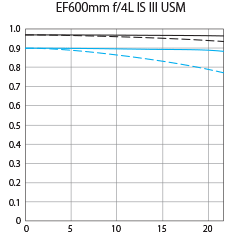 |
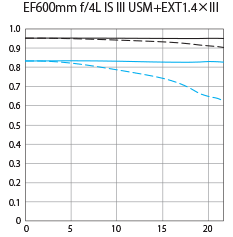 |
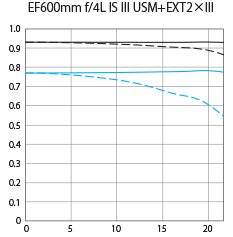 |
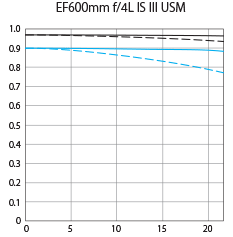
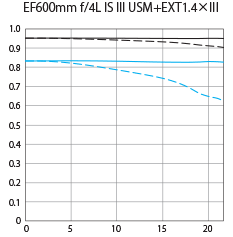
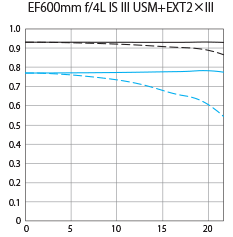












Featuring carefully refined optics, the EF 600mm f/4L IS III USM offers a familiar feel to its predecessor while being even more comfortable to handle thanks to its significantly lighter build.
Super UD lens elements offer improved image quality while being more compact in size, while the Image Stabilizer unit has also had its weight reduced. This results in a lens that’s more than twenty percent, or approx. 1.92 lbs., lighter than its predecessor. Optical placement has also been improved, with the center of gravity now closer to the rear. This allows users to position the lens more easily for fast framing of moving subjects.
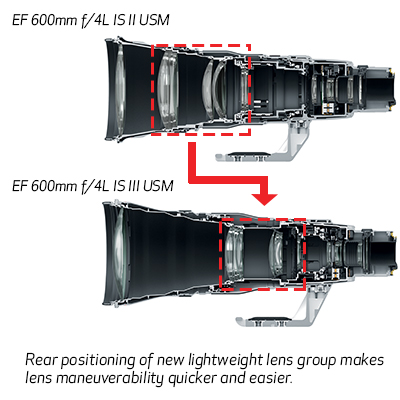
An excellent addition to Canon’s L series collection of lenses, the EF 600mm f/4L IS III USM offers outstanding optics, reliable performance and a refined design, featuring the quality professionals and advanced photographers demand. Engineered to complement Canon’s high-resolution camera sensors, it’s poised to deliver phenomenal image quality in any number of applications.
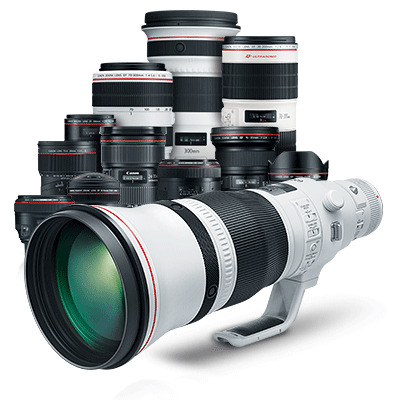
To create memorable images with vibrant colors and deep lifelike contrast, minimizing unwanted flare and ghosting is crucial. Canon’s Super Spectra Coating (SSC) helps reject extraneous light wavelengths, maintaining overall image quality and color fidelity. Additionally, Canon’s Air Sphere Coating (ASC) helps minimize unwanted glare and reflections.
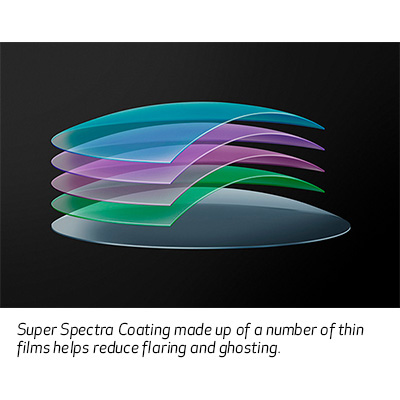
Even when used outdoors in the heat for extended periods of time, the EF 600mm f/4L IS III USM delivers consistent and reliable performance you can trust. A new paint formulation reflects even more heat than before, while a two-layer barrel structure helps reduce the thermal effects on the lens elements. Together, these technologies help maintain image quality and lens reliability even during long shoots under the hot sun.
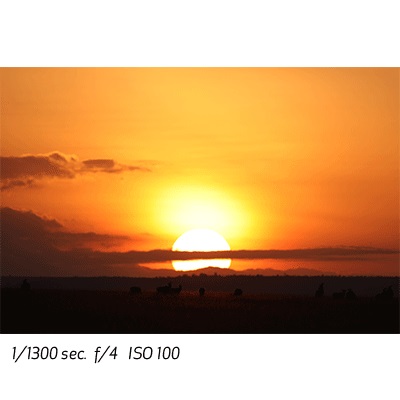
Built to L series lens specifications, the EF 600mm f/4L IS III USM features a highly durable design for excellent performance even in inclement weather conditions. It delivers a dust- and water-resistant construction with seals around the mount, switches, rings and more.
To help maintain a clean lens, even after multiple lens changes in sub-optimal conditions, the EF 600mm f/4L IS III USM has a specially designed fluorine coating on its front and rear surfaces. This fluorine coating helps to prevent water, oil and other surface residue like fingerprints from sticking to the lens, which facilitates quick and easy wiping, without the use of solvents.
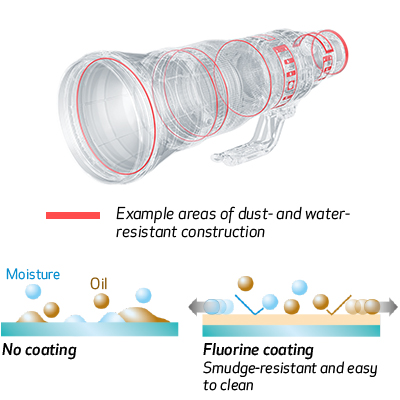
A customizable electronic manual focusing ring helps ensure you’ll get the shot that you want at the right moment. Three sensitivity levels are available to select how quick and precise you want to adjust the focus. This can help whether you need a slow speed to switch between someone’s eyes in a distant profile, or a fast speed to dial in on different birds in a large, swiftly moving flock. Additionally, manual focus is still possible while autofocus is engaged, letting you finetune focus adjustments to suit your shooting preferences.
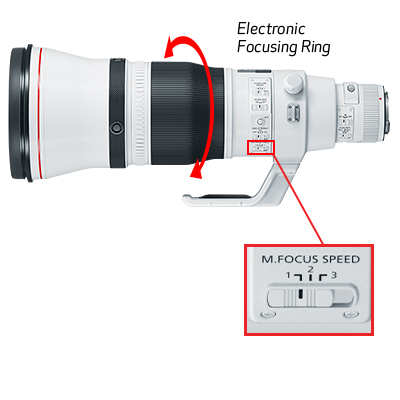
Quickly select between two points with focus presets. Especially useful for fixed-position sports photography, you can choose two exact focus distances, and with a simple twist of the recall ring, swap between them. If you’re on the sidelines of a soccer game, one focus point could be the home team’s goal, and the other point the visiting team’s goal. A twist of the recall ring will help ensure your most important photos are sharply in focus.
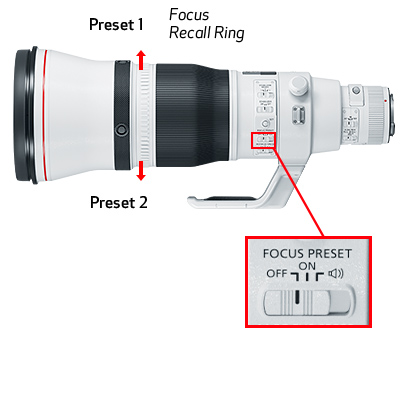
For consistent, sharp results, the EF 600mm f/4L IS III USM features an Optical Image Stabilizer system that provides shake reduction for up to 5 shutter speed stops*. This helps provide reliable handheld performance and clear image detail in low-light situations or at lower ISOs.
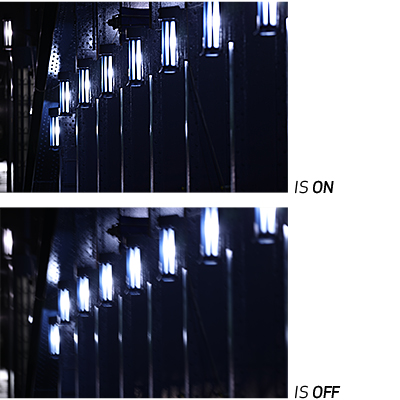
*Based on CIPA (Camera & Imaging Products Association) standards. Testing performed at a focal length of 200mm using the EOS-1D X Mark II digital SLR camera.
The EF 600mm f/4L IS III USM can help you get close to your subjects with a minimum focusing distance of approx. 13.8 ft./4.2m. This makes it easy to fill the frame with details, letting you capture action-packed scenes for dynamic and impressive results.
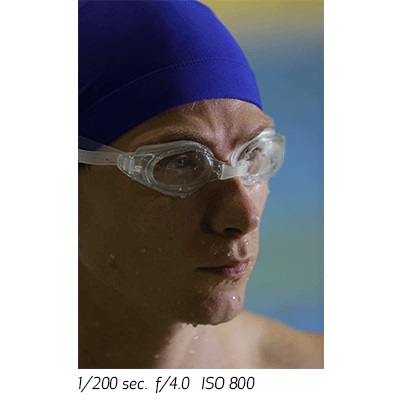
The EF 600mm f/4L IS III USM features a 9-blade, circular aperture to help create gorgeous, evocative out-of-focus areas and soft backgrounds. With an incredible level of control over background blur, the 9-blade circular aperture helps create intimacy and intensity in both photos and videos for impactful results.
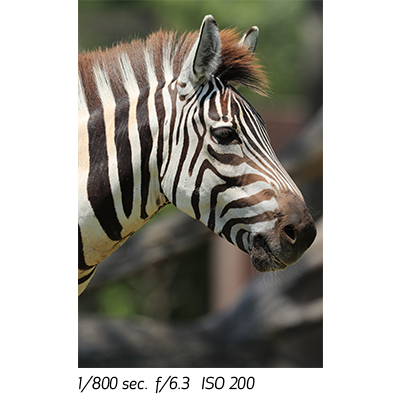
* Based on CIPA (Camera & Imaging Products Association) standards. Testing performed at a focal length of 200mm using the EOS-1D X Mark II digital SLR camera.
| Focal Length Maximum Aperture | 600mm F/4 |
| Lens Construction | 17 Elements In 13 Groups |
| Diagonal Angle Of View | 04°10' |
| Focus Adjustment | Manual Focus |
| Closest Focusing Distance | 13.78 Ft. / 4.2m |
| Filter Size | 52mm |
| Max Diameter X Length Weight | Φ6.6 X 17.6 In., Approx. 6.73 Lbs. / Φ168.0 X 448.0mm, Approx. 3050g |
* Based on CIPA (Camera & Imaging Products Association) standards. Testing performed at a focal length of 200mm using the EOS-1D X Mark II digital SLR camera.

Lens Case 600C
Hard lens case covers and protects your lens from scratches, dust and more when not being used.

Lens Soft Case LS600
Soft lens case covers and protects your lens from scratches, dust and more when not being used.
)
Lens Hood ET-160 (WIII)
Designed to prevent stray light from entering the lens in order to keep unwanted glare from affecting your photographs.

Lens Short Hood ET-160B
Designed to prevent stray light from entering the lens in order to keep unwanted glare from affecting your photographs.

Lens Dust Cap E Rear Cap
Rear lens cap for all EF type lenses, lens extenders, and extension tubes. Used to protect the rear glass element from dust and scratches.

Lens Cap E-185C
Helps protect the front glass from dust and scratches.
)
Drop-in Circular Polarizing Filter PL-C 52 (WIII)
Circular Polarizing filter for use with Canon EF lenses.
-with-52mm-protect-filter)
Drop-in Screw Filter Holder 52 (WIII) with 52mm Protect Filter
The 52mm Drop-in Filter Holder accepts 52mm screw-in filters and is easy to insert and remove.
)
Drop-in Gelatin Filter Holder 52 (WIII)
Allows you to fit various gels on your Canon telephoto lenses that accept 52mm filters in their standard holder.
- Windows Server 2025
- macOS 15
- macOS 14
- macOS 13
- Windows 11
- macOS 12
- Windows Server 2022
- macOS 11
- Linux MIPS
- Linux ARM
- macOS 11.0
- macOS 10.15
- macOS v10.13
- macOS v10.14
- Windows Server 2019 (x64)
- macOS v10.14
- macOS v10.13
- Windows Server 2016 (x64)
- macOS v10.12
- Linux 64bit
- Linux 32bit
- OS X v10.11
- Windows 10
- Windows 10 (x64)
- OS X v10.10
- Windows Server 2012 R2 (x64)
- OS X v10.9
- Windows 8.1 (x64)
- Windows 8.1
- Windows Server 2012 (x64)
- Windows 8
- Windows 8 (x64)
- Windows 7
- Windows 7 (x64)
- Windows Vista
- Windows Vista (x64)
- Windows XP
- Windows XP (x64)
- Windows Server 2008
- Windows Server 2008 (x64)
- Windows Server 2008 R2 (x64)
- Windows Server 2003
- Windows Server 2003 (x64)
- Windows Server 2003 R2
- Windows Server 2003 R2 (x64)
- Windows 2000
- Windows NT
- Windows 3.1
- Windows Me
- Windows 98
- Windows 95
- Mac OS X v10.8
- Mac OS X v10.7
- Mac OS X v10.6
- Mac OS X v10.5
- Mac OS X v10.4
- Mac OS X v10.3
- Mac OS X v10.2
- Mac OS X v10.1
- Mac OS X
- Mac OS 9
- Mac OS 8
- Linux (x64)
- Linux (x32)
- Linux
- Not Applicable
Locating and Installing Your Download Cómo Localizar e Instalar su Descarga Localizando e Instalando seu Download
How to identify your OS version
To help determine which Windows operating system is running on your computer, please view the below steps:
Windows 11
Click on the Windows button (located left to the Search at the bottom).
Click on the Settings button to navigate to the system settings.
Scroll to the bottom of the page and click on the About button.
You will be able to find your Windows operating system under the Windows Specifications section.
Windows® 10
Click Start or click the Windows button (usually found in the lower-left corner of your screen).
Click Settings.
Click About (which is usually located within the lower left of the screen). The next screen should display the Windows version.
Windows 8 or Windows 8.1
Option1: Swipe in from the upper-right corner of the screen while viewing the desktop in order to open the menu, then select Settings.
Select PC Info. Under Windows edition, the Windows version is shown.
Option 2: From the Start Screen
While on the Start screen, type computer.
Right-click on the computer icon. If using touch, press and hold on the computer icon.
Click or tap Properties. Under Windows edition, the Windows version is shown.
Windows 7
Click Start or click the Windows button (usually found in the lower-left corner of your screen).
Right-click Computer and select Properties from the menu. The resulting screen should now display the Windows version.
Linux
To check the version of your Linux operating system (OS), you can use the following commands in your terminal:
1. uname -r: Displays your Linux kernel version.
2. cat /etc/os-release: Displays your distribution name and version.
3. lsb_release -a: Displays specific details about your Linux distribution and version.
4. You can also use the hostnamectl command to display the Linux kernel version. However, this command is only available on Linux distributions that use systemd by default.
To help determine which Mac operating system is running on your computer, select the Apple menu in the upper-left corner of your screen and choose About This Mac.
Upon selecting, you should see the macOS name followed by the version number.
Canon U.S.A Inc. All Rights Reserved. Reproduction in whole or part without permission is prohibited.